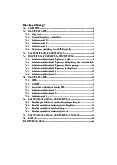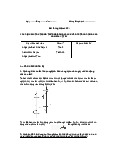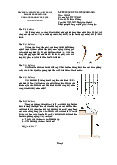


Preview text:
Chapter 13
(CQ13. 2, 4, 7, 8, 9; P13. 6, 9, 12, 14, 15, 18, 21, 28, 30, 33, 37, 39, 45, 53, 76)
1. (CQ13.2) In his 1798 experiment, Cavendish was said to have Trong thí nghiệm của Cavendish năm 1798, ông nói rằng Trái Đất có trọng l°ợng. Giải thích điều ông nói??!!
2. (CQ13.4) (a) Explain why the force exerted on a particle by a uniform sphere must be directed toward the
center of the sphere. (b) Would this statement be true if the mass distribution of the sphere were not spherically symmetric? Explain.
(a) Hãy giải thích tại sao lực tác dụng vào chất điểm bởi một quả cầu đồng nhất có ph°¡ng chiều h°ớng về
phía tâm của quả cầu? (b) Mệnh đề ở câu a có còn đúng không nếu quả cầu phân bố khối l°ợng không đồng nhất. Giải thích.
3. (CQ13.7) (a) If a hole could be dug to the center of the Earth, would the force on an object of mass m still
obey Equation 13.1 there? (b) What do you think the force on m would be at the center of the Earth?
(a) Nếu một cái lỗ đ°ợc đào đến tâm Trái Đất, liệu lực tác dụng lên vật khối l°ợng m vẫn tuân theo ph°¡ng
trình 13.1? (b) Lực tác dụng vào m ở tâm Trái Đất là thế nào?
4. (CQ13.8) Explain why it takes more fuel for a spacecraft to travel from the Earth to the Moon than for the
return trip. Estimate the difference.
Hãy giải thích tại sao phải tốn nhiều nhiên liệu h¡n khi tàu thám hiểm đi từ Trái Đất đến Mặt Trăng h¡n là
chiều ng°ợc lại? ¯ớc đoán sự khác nhau đó.
5. (CQ13.9) A satellite in low-Earth orbit is not truly traveling through a vacuum. Rather, it moves through very
thin air. Does the resulting air friction cause the satellite to slow down?
Một vệ tinh có quỹ đạo gần Trái Đất đang chuyển động đi qua một vùng không khí rất mỏng. Hỏi rằng lực
cản không khí ảnh h°ởng nh° thế nào đến tốc độ của vệ tinh?
6. (P13.6) Three uniform spheres of masses m 2kg , m 4kg , and m 6kg are placed at the corners of a 1 2 3
right triangle as shown in Figure P13.6. Calculate the resultant gravitational force on the
object of mass m , assuming the spheres are isolated from the rest of the Universe. 2
Ba quả cầu đồng nhất có khối l°ợng m1 = 2kg, m2 = 4kg, và m3 = 6kg đặt ở các góc của
tam giác vuông nh° trong hình. Tính lực hấp dẫn lên vật m2. Giả sử các quả cầu cô lập trong vũ trụ ng yên. đứ
ĐS: (210ÿ + 5.9Ā) × 10211�㕁
7. (P13.9) Two objects attract each other with a gravitational force of magnitude 8
1.10 N when separated by
20cm . If the total mass of the two objects is 5kg , what is the mass of each?
Hai vật hút nhau bằng lực hấp dẫn có độ lớn 10-8N khi chúng cách nhau 20cm. Nếu tổng khối l°ợng của hai
vật là 5kg thì kh ng c ối l°ợ
ủa từng vật là bao nhiêu? ĐS: 3kg và 2kg
8. (P13.12) The free-fall acceleration on the surface of the Moon is about one-sixth that on the surface of the
Earth. The radius of the Moon is about R ø 6 0, 25
R Earth 's radius 6,37.10 m . Find the ratio of their E E ù average densities / . Moon Earth
Gia tốc r¡i tự do t i ạ bề m t ặ M t
ặ Trăng bằng 1/6 gia tốc r¡i tự do t i
ạ bề mặt Trái Đất, bán kính c a ủ mặt trăng khoảng 0.25R 6 E (v i
ớ RE là bán kính Trái đất, RE = 6.37x10 m). Tìm tỷ s k ố h ng ối l°ợ
riêng trung bình c a m ủ ặt
trăng và mặt trời (ρMT/ ρTĐ). ĐS: 2/3
9. (P13.14) (a) Compute the vector gravitational field at a point P on the perpendicular bisector of the line joining
two objects of equal mass separated by a distance 2a as shown in Figure P13.14. (b) Explain physically why
the field should approach zero as r 0. (c) Prove mathematically that the answer to part (a)
behaves in this way. (d) Explain physically why the magnitude of the field should approach 2
2GM / r as r . (e) Prove mathematically that the answer to part (a) behaves correctly in this limit. (a) Tìm gia t c ố h p d ấ n t
ẫ ại điểm P nằm trên đ°ờng trung trực n i
ố 2 vật M cách nhau đoạn 2a nh° hình. (b,c)
Chứng minh và giải thích tại sao khi ÿ → 0 thì gia tốc hấp dẫn gần bằng 0. (d,e) Chứng minh và giải thích
tại sao khi ÿ → t ∞ hì gia t c ố h p d ấ n g ẫ n b ầ ng ằ 2�㔺�㕀 �㕟2 . 2�㔺�㕀�㕟 ĐS: (�㕟2+�㕎 ⁄ 2)3 2
10. (P13.15) Three objects of equal mass are located at three corners of a square of edge length l as shown in
Figure P13.15. Find the magnitude and direction of the gravitational field at the fourth corner due to these objects.
Ba quả cầu có khối l°ợng nh° nhau đ°ợc đặt tại các vị trí của một hình vuông có chiều dài
cạnh là l nh° trong hình. Tìm độ lớn và h°ớng của gia tốc trọng tr°ờng ở O. �㔺�㕀 ĐS: (√2 + 1 ) �㔼2 2
11. (P13.18) Io, a satellite of Jupiter, has an orbital period of 1,77 days and an orbital radius of 5 4, 22.10 km .
From these data, determine the mass of Jupiter. Io, m t
ộ vệ tinh của sao m c
ộ , có chu kỳ là 1.77 ngày và bán kính quỹ o
đạ là 4.22x105km. T
ừ những dữ liệu
này hãy xác định khối l°ợng của Sao Mộc.
ĐS: 1.9 × 1027�㕘�㕔 12. (13.21)
Plaskett’s binary system consists of two stars that revolve in a circular orbit about a center of mass
midway between them. This statement implies that the masses of the two stars are equal (Fig. P13.21).
Assume the orbital speed of each star is v 220km / s and the orbital period of each is 14, 4 days. Find the
mass M of each star. (For comparison, the mass of our Sun is 30 1,99.10 kg ).
Hệ thống nhị phân Plaskett gồm 2 ngôi sao có khối l°ợng bằng nhau và chuyển động với quỹ
đạo tròn quanh khối tâm nh° hình. Giả sử tốc độ của 2 ngôi sao là |�㕣| = 220 �㕘�㕚/Ā và có chu
kỳ 14.4 ngày. Tìm khối l°ợng M của mỗi ngôi sao và so sánh xem nó bằng bao nhiêu lần khối
l°ợng mặt trời biết kh ng m ối l°ợ
ặt trời là 1.99 × 1030�㕘�㕔. ĐS: 1.26 × 1032�㕘�㕔
13. (P13.28) (a) Given that the period of the Moon’s orbit about the Earth is 27,32 days and the nearly constant
distance between the center of the Earth and the center of the Moon is 8
3,84.10 m , use Equation 13.11 to
calculate the mass of the Earth. (b) Why is the value you calculate a bit too large? (a) Chu kỳ M t
ặ Trăng quay quanh Trái Đất là 27.32 ngày và kho ng ả
cách từ tâm của Trái Đất đến tâm của
Mặt Trăng là 3.84x108m là hằng số. Sử dụng ph°¡ng trình 13.11 để tính toán khối l°ợng của Trái Đất. (b)
Tại sao giá trị b n t
ạ ính nó lại h¡i lớn so với kết qu ả c
đo đạ 5.98 × 1024�㕘� . 㕔 ĐS: 6.02 × 1024�㕘�㕔
14. (P13.30) A satellite in Earth orbit has a mass of 100kg and is at an altitude of 6
2.10 m . (a) What is the
potential energy of the satellite–Earth system? (b) What is the magnitude of the gravitational force exerted by
the Earth on the satellite? (c) What If? What force, if any, does the satellite exert on the Earth?
Một vệ tinh của Trái Đất có khối l°ợng là 100kg và ở độ cao 2x106m. (a) Thế p d năng hấ n c ẫ a h ủ
ệ vệ tinh –
Trái Đất là bao nhiêu? (b) Độ lớn của lực hấp dẫn lên vệ tinh là bao nhiêu? (c) Nếu nh° vậy lực của vệ tinh
tác động lên Trái Đất bao nhiêu?
15. (P13.33) After the Sun exhausts its nuclear fuel, its ultimate fate will be to collapse to a white dwarf state. In
this state, it would have approximately the same mass as it has now, but its radius would be equal to the radius
of the Earth. Calculate (a) the average density of the white dwarf, (b) the surface free-fall acceleration, and
(c) the gravitational potential energy associated with a 1kg object at the surface of the white dwarf. Sau khi M t ặ Trời c n
ạ kiệt nhiên liệu h t
ạ nhân nó sẽ r¡i xuống sao lùn tr n ắ g. Trong tr ng ạ
thái này nó sẽ có
khối l°ợng xấp xỉ nh° khối l°ợng hiện có và bán kính của nó sẽ bằng bán kính của Trái Đất. Tính (a) khối
l°ợng riêng của sao lùn trắng, (b) gia tốc r¡i tự do mặt trời ở bề mặt và (c) thế năng hấp dẫn ở bề mặt sao lùn trắng.
16. (P13.37) A 500kg satellite is in a circular orbit at an altitude of 500km above the Earth’s surface. Because
of air friction, the satellite eventually falls to the Earth’s surface, where it hits the ground with a speed of
2km/s. How much energy was transformed into internal energy by means of air friction?
Một vệ tinh nặng 500kg ban đầu nằm trong quỹ đạo tròn ở độ cao 500km trên mặt đất sau đó r¡i xuống bề
mặt trái đất. Do có lực c n k ả
hông khí nên nó chạm đất với tốc độ 2km/s. Hỏi l°ợng năng l°ợng đ°ợc chuyển
hóa thành nội năng do lực c n k ả
hông khí là bao nhiêu? Biết khối l°ợng Trái Đất ME = 5.28x1024kg, bán kính
Trái Đất RE = 6.37x106m. ĐS: 1.58 × 1010�㔽
17. (P13.39) A 1000kg satellite orbits the Earth at a constant altitude of 100km . (a) How much energy must be
added to the system to move the satellite into a circular orbit with altitude 200km ? What are the changes in
the system’s (b) kinetic energy and (c) potential energy?
Một vệ tinh nặng 1000kg quay quanh trái đất ở độ cao không đổi 100km.(a) L°ợng năng l°ợng cần phải bổ
sung vào để chuyển vệ tinh sang quỹ đạo tròn với độ cao 200km. Tính độ biến thiên (b) động năng và (c) thế năng của hệ. ĐS: 4.69 × 108�㔽
18. (P13.45) A satellite of mass 200kg is placed into Earth orbit at a height of 200km above the surface. (a)
Assuming a circular orbit, how long does the satellite take to complete one orbit? (b) What is the satellite’s
speed? (c) Starting from the satellite on the Earth’s surface, what is the minimum energy input necessary to
place this satellite in orbit? Ignore air resistance but include the effect of the planet’s daily rotation.
Một vệ tinh có khối l°ợng 200kg đ°ợc đặt vào trái t
đấ ở độ cao 200km trên bề mặt Trái Đất. (a) Giả sử vệ
tinh chuyển động theo quỹ o, t đạ
ính chu kỳ quay c a v ủ
ệ tinh. (b) Tốc độ của vệ tinh là bao nhiêu? (c) Giả sử
ban đầu vệ tinh ở bề mặt trái đất, tính năng l°ợng tối thiểu để bắn vệ tinh lên tới quỹ đạo 200km nh° trên.
Bỏ qua ảnh h°ởng của không khí nh°ng tính đến ảnh h°ởng do sự quay của hành tính. ĐS: 6.43 × 109�㔽
19. (P13.53) A satellite is in a circular orbit around the Earth at an altitude of 6
2,8.10 m. Find (a) the period of
the orbit, (b) the speed of the satellite, and (c) the acceleration of the satellite.
Một vệ tinh nằm trong quỹ đạo tròn quanh trái đất ở độ cao 2.8x106m. Tìm (a) chu kỳ quay, (b) tốc độ và (c)
gia tốc của vệ tinh.
ĐS: 2.43h; 6.6km/s; 4.74m/s2
20. (P13.76) Consider an object of mass m , not necessarily small compared with the mass of the Earth, released at a distance of 7
1, 2.10 m from the center of the Earth. Assume the Earth and the object behave as a pair of
particles, isolated from the rest of the Universe. (a) Find the magnitude of the acceleration a with which rel
each starts to move relative to the other as a function of m. Evaluate the acceleration (b) for m 5kg , (c) for
m 2000kg , and (d) for 24
m 2.10 kg . (e) Describe the pattern of variation of a with m . rel
Một vật có khối l° ng m ợ
đ°ợc phóng từ vị trí cách tâm Trái Đất 1.2x107m. Giả sử Trái Đất là chất điểm và
cô lập trong Vũ trụ. (a) Tìm đ l ộ n c ớ a ủ gia t c ố arel c a v ủ
ật theo m. Tính giá trị c a gi ủ a t c
ố ở các tr°ờng h p ợ
sau (b) m = 5kg, (c) m = 2000kg và (d) m = 2x1024kg. (e) Mô t s
ả ự tay đổi c a a ủ rel theo m.
ĐS: 2.77m/s2; 2.77m/s2; 3.7m/s2




